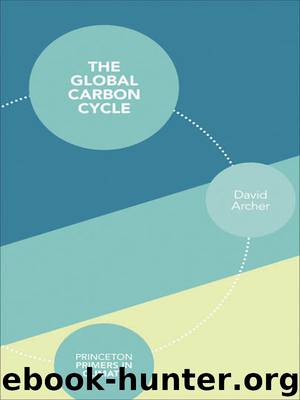The Global Carbon Cycle by Archer David;

Author:Archer, David;
Language: eng
Format: epub
Publisher: Princeton University Press
Changes in Ocean pH
Perhaps the glacial world hid the carbon as bicarbonate dissolved in seawater. Seawater has 100 times more bicarbonate than dissolved CO2. changing the balance between CO2 and bicarbonate would require a change in ocean pH, which is controlled by the CaCO3 cycle pH-stat. It might be useful here to review box 3.1, “carbonate System pH chemistry,” and box 3.3, “The CaCO3 cycle.”
One possibility would be to increase the rate of weathering of CaCO3 on land. With all else held constant, more dissolved CaCO3 flowing into the ocean would drive up ocean pH until CaCO3 accumulated more quickly on the seafloor to keep pace. Did this happen? The best indication, the most direct measurement, would be to see more CaCO3 accumulating on the seafloor during glacial time (see box 3.3, “The CaCO3 cycle”). There are a few places on the seafloor with clear increases in CaCO3 burial during glacial times, but overall there's no convincing evidence that the global burial rate of CaCO3 in the deep sea was much different than it is today.
Another theory for lowering glacial atmospheric CO2 via pH is called the coral reef hypothesis, which proposes that CaCO3 depositing in shallow waters today moved to the deep sea during glacial times (Berger and Keir 1984). Today, lots of CaCO3 accumulates in shallow waters on the continental shelves. Lowered sea levels during glacial times left most of that area high and dry, subject to erosion instead of sedimentation. Deprived of shallow-water sediments, the ocean might have needed a higher pH to bury enough CaCO3 in the deep sea to balance the influx from weathering.
The coral reef hypothesis is undermined by the same observation that torpedoed the increased CaCO3 weathering idea; the global burial rate of CaCO3 in the deep ocean was not very different during glacial times than it is today. That doesn't mean that the ideas are wrong, but it limits how much CO2 drawdown can be explained by these mechanisms to maybe 10-20 ppm or so, a fraction of the total drawdown. Where have we heard that before?
The distribution of CO2 in the ocean might affect the setting of the pH-stat (Boyle 1988). Nutrients in the ocean travel with metabolic CO2 (see box 3.3, “Biological Pump in the Ocean”), and the concentrations of both are generally higher near the seafloor during glacial times. Deep water from Antarctica is high in CO2, and it covered more of the seafloor during glacial times. The deep salty blob might have been particularly acidic. Putting CO2 near the seafloor prevents CaCO3 from accumulating, and the CaCO3 pH-stat would have responded by raising the pH of the ocean. Again, however, the potential CO2 drawdown from this mechanism appears to be too small to explain the entire drawdown.
The burial of CaCO3 on the seafloor may depend on the balance of organic carbon and CaCO3, called the rain ratio, of the sinking particles that land on the seafloor (Archer and Maier-Reimer 1994). Organic carbon when it decomposes releases CO2, an acid that causes CaCO3 to dissolve.
Download
This site does not store any files on its server. We only index and link to content provided by other sites. Please contact the content providers to delete copyright contents if any and email us, we'll remove relevant links or contents immediately.
Man-made Catastrophes and Risk Information Concealment by Dmitry Chernov & Didier Sornette(4731)
The Revenge of Geography: What the Map Tells Us About Coming Conflicts and the Battle Against Fate by Kaplan Robert D(3596)
Zero Waste Home by Bea Johnson(3286)
COSMOS by Carl Sagan(2944)
In a Sunburned Country by Bill Bryson(2941)
Good by S. Walden(2910)
The Fate of Rome: Climate, Disease, and the End of an Empire (The Princeton History of the Ancient World) by Kyle Harper(2431)
Camino Island by John Grisham(2379)
A Wilder Time by William E. Glassley(2358)
Organic Mushroom Farming and Mycoremediation by Tradd Cotter(2304)
Human Dynamics Research in Smart and Connected Communities by Shih-Lung Shaw & Daniel Sui(2175)
The Ogre by Doug Scott(2105)
Energy Myths and Realities by Vaclav Smil(2054)
The Traveler's Gift by Andy Andrews(2008)
Inside the Middle East by Avi Melamed(1937)
Birds of New Guinea by Pratt Thane K.; Beehler Bruce M.; Anderton John C(1905)
Ultimate Navigation Manual by Lyle Brotherton(1764)
A History of Warfare by John Keegan(1712)
And the Band Played On by Randy Shilts(1612)
